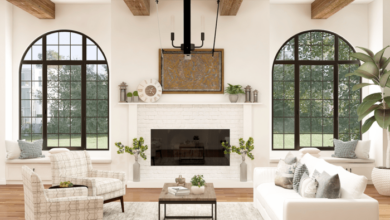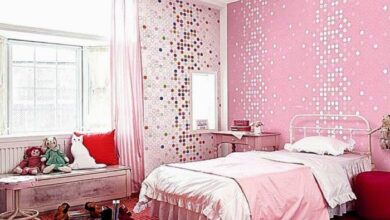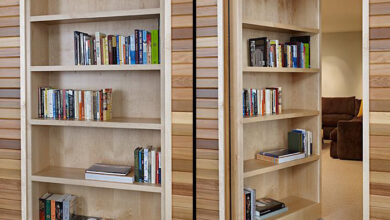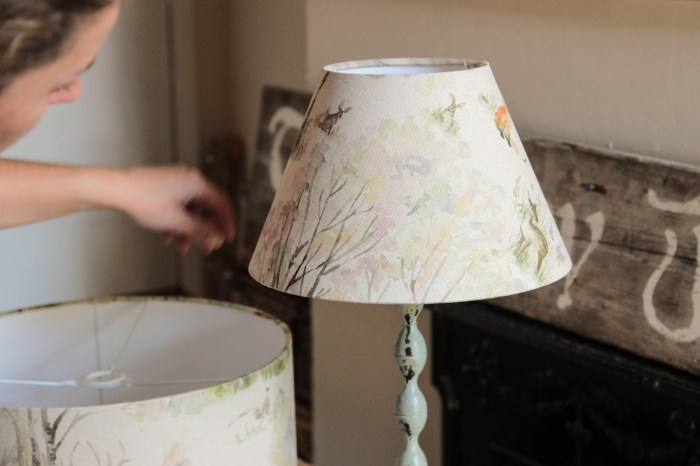
Bright Idea DIY Lampshade Covers: Transform Your Lighting
Bright Idea DIY Lampshade Covers: Tired of the same old boring lampshades? Ready to inject some personality into your home décor? Then you’ve come to the right place! Creating your own lampshade covers is an incredibly rewarding and surprisingly easy DIY project that lets you unleash your creativity and express your unique style.
From simple fabric covers to elaborate, textured masterpieces, the possibilities are endless.
With a little imagination and a few basic supplies, you can transform a drab lampshade into a stunning focal point that reflects your personality and enhances your room’s ambiance. Whether you’re looking to add a touch of whimsy, a splash of color, or a sophisticated touch of elegance, DIY lampshade covers are the perfect way to personalize your home lighting.
Introduction to DIY Lampshade Covers
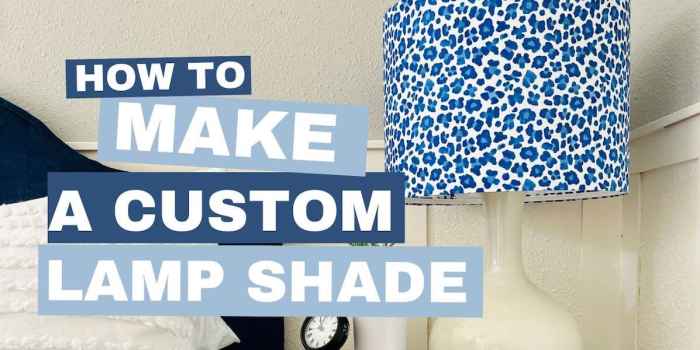
Transforming a basic lampshade into a unique and stylish statement piece is within your reach with the art of DIY lampshade covers. Whether you’re looking to refresh your home decor, add a touch of personality to your space, or simply embrace your creative side, DIY lampshade covers offer a rewarding and affordable solution.
Creating your own lampshade covers provides numerous advantages over commercially available options. You have the freedom to personalize your lampshades, selecting materials, colors, and patterns that perfectly complement your existing décor. Moreover, DIY projects allow you to express your creativity and design skills, resulting in truly unique and one-of-a-kind lampshades.
Materials and Tools Used in DIY Lampshade Projects
The materials and tools required for DIY lampshade projects are readily available and often inexpensive. Here’s a general overview:
- Fabric:This is the heart of your lampshade cover. Choose fabrics that are lightweight, durable, and easy to work with, such as cotton, linen, silk, or even burlap.
- Glue:A fabric glue or adhesive specifically designed for attaching fabric to fabric or fabric to surfaces is essential. It ensures a strong and lasting bond.
- Scissors:Sharp scissors are crucial for precise cutting of fabric and other materials.
- Measuring Tape:Accurately measuring your lampshade is essential for creating a well-fitting cover.
- Sewing Machine (Optional):If you’re comfortable with sewing, a sewing machine can be helpful for creating a more polished and professional finish.
- Iron:Pressing your fabric before and after sewing helps to ensure a smooth and wrinkle-free finish.
- Safety Pins:Safety pins are useful for temporarily holding fabric in place while you’re working.
Inspiration and Design Ideas
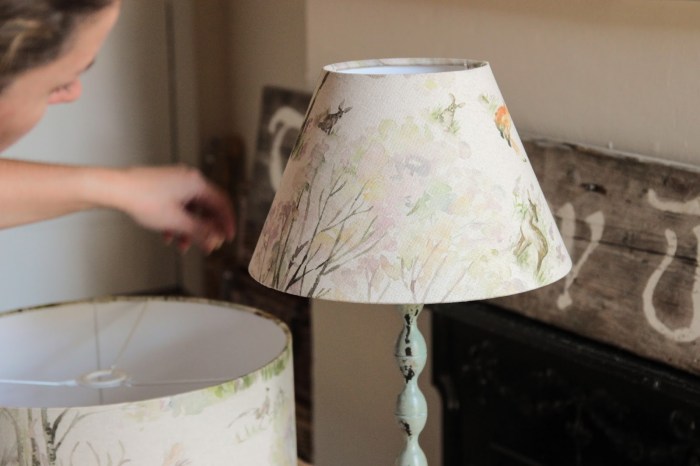
Transforming a plain lampshade into a stylish and personalized accent piece is an exciting creative journey. With a little imagination and some basic materials, you can craft a lampshade cover that reflects your unique style and enhances your home décor.
Choosing a Design Style
The design style of your lampshade cover should complement the existing lamp and the overall décor of the room. Consider the following design styles:
- Modern: Clean lines, geometric patterns, and minimalist designs are characteristic of modern style. Opt for neutral colors like white, black, gray, or metallic finishes. You can use materials like fabric, paper, or even metal mesh for a contemporary look.
- Rustic: Embrace natural textures and earthy tones for a rustic aesthetic. Think burlap, twine, wood, or leather for a warm and inviting feel. You can add accents like dried flowers, twigs, or vintage buttons to enhance the rustic charm.
- Vintage: For a vintage vibe, consider using fabrics like velvet, lace, or floral prints. You can incorporate antique buttons, beads, or lace trims for a touch of nostalgia. Think of using a vintage lampshade as inspiration for your design.
- Contemporary: Contemporary style is all about bold colors, unexpected textures, and unique shapes. Experiment with different materials, such as metallic fabrics, patterned papers, or even repurposed items like old maps or sheet music.
Popular Materials for Lampshade Covers
The materials you choose will significantly impact the final look and feel of your lampshade cover. Here are some popular materials:
- Fabric: Fabric is a versatile and readily available material for lampshade covers. You can find a wide variety of colors, patterns, and textures, from cotton and linen to silk and velvet. Consider using a fabric that complements the style of your lamp and room.
- Paper: Paper is a lightweight and affordable material for lampshade covers. You can use decorative papers, wrapping paper, or even old maps or sheet music for a unique look. Paper can be easily cut, glued, and shaped, making it ideal for creating intricate designs.
Turning an old lampshade into a festive centerpiece with a DIY cover is a great way to add a personal touch to your holiday decor. It’s all about creating those special moments, and you can find inspiration for other budget-friendly traditions in this fantastic article on frugal fun family tradition 7 magical moments under the christmas tree.
Once you’ve got your lampshade covered, you can create a warm and inviting atmosphere for your holiday gatherings, and the memories you make will be even brighter than the twinkle lights!
- Rope: Rope adds a natural and rustic touch to lampshade covers. You can use twine, jute, or sisal rope to create a textured and organic look. Rope can be easily wrapped around the lampshade, and you can add embellishments like beads or feathers for extra detail.
Sometimes the best ideas come from unexpected places! I was brainstorming DIY lampshade covers when I stumbled upon these fantastic earth day plant a tree printables and realized they’d make amazing patterns for a lampshade. Now I’m picturing a leafy green lampshade casting a whimsical glow in my living room.
It’s a reminder that even small projects can contribute to a bigger cause, and maybe inspire others to plant a tree too!
- Beads: Beads can be used to create a glamorous and eye-catching lampshade cover. You can use a variety of beads, from glass and metal to wood and plastic, to create a unique and personalized design. Consider using a combination of different bead sizes and colors for a visually interesting effect.
Step-by-Step Guide for Creating a Lampshade Cover
This step-by-step guide will walk you through the process of creating a simple lampshade cover using fabric, making it a fun and achievable DIY project.
Gathering Supplies
Before embarking on your lampshade cover creation journey, ensure you have all the necessary materials.
I was recently trying to come up with a unique way to revamp my lampshade and then it hit me – I could use some of my boyfriend’s old ties! It’s amazing how you can find inspiration in the most unexpected places, and using your man’s accessories is a great way to add a touch of personality to your decor.
The colors and patterns on the ties would add a cool, vintage vibe to my lampshade, and I think it would look really stylish. I can’t wait to get started on this DIY project!
- Lampshade: The foundation of your project, choose a lampshade that fits your style and lighting needs.
- Fabric: Select a fabric that complements your decor and lampshade’s style. Consider factors like texture, weight, and color.
- Scissors: Sharp scissors are essential for precise cutting.
- Sewing machine: A sewing machine simplifies the process, but hand sewing is also an option.
- Thread: Choose thread that matches your fabric color.
- Measuring tape: Accurate measurements are crucial for a well-fitting cover.
- Safety pins: Useful for temporarily securing fabric while sewing.
- Iron: Pressing seams helps create a professional finish.
Measuring the Lampshade
- Circumference:Measure the widest part of the lampshade’s circumference. Add an extra inch or two for seam allowance.
- Height:Measure the height of the lampshade, from the top to the bottom, including the finial (the decorative piece at the top). Add an extra inch for seam allowance.
Cutting the Fabric
- Once you have the measurements, cut two rectangular pieces of fabric. Each rectangle should be the same width as the lampshade’s circumference plus seam allowance, and the height of the lampshade plus seam allowance.
Sewing the Fabric
- Place the two fabric rectangles right sides together. Pin the sides together, leaving the top and bottom edges open.
- Sew along the pinned sides, using a straight stitch. Remove the pins as you sew.
- Turn the fabric right side out. Press the seams flat.
Attaching the Fabric to the Lampshade, Bright idea diy lampshade cover
- Slip the fabric cover over the lampshade, ensuring the seam is on the back or bottom side. Use safety pins to temporarily hold the fabric in place.
- Sew the top and bottom edges of the fabric to the lampshade frame. You can use a sewing machine or hand sew, making sure to secure the fabric to the frame.
- Remove the safety pins.
Finishing Touches
- Press the seams again for a crisp finish.
- If desired, you can add embellishments like trim, ribbons, or buttons to enhance the lampshade cover.
Creative and Unique DIY Lampshade Ideas: Bright Idea Diy Lampshade Cover
Now that you have a basic understanding of how to create a lampshade cover, let’s explore some creative and unique ideas that will truly make your lampshade stand out. You can transform an ordinary lampshade into a stunning centerpiece for your home with a little imagination and some simple materials.
Recycled Materials for Lampshade Covers
Using recycled materials is an excellent way to give your lampshade a unique and eco-friendly makeover. Old magazines, maps, and fabric scraps can all be repurposed to create beautiful and textured lampshade covers.
- Magazine Covers:Cut out interesting images or patterns from old magazines and glue them onto the lampshade. You can create a collage effect or use a single image for a more minimalist look.
- Maps:Maps can be used to create a vintage or travel-inspired lampshade cover. You can use a whole map or cut out specific sections to create a more abstract design.
- Fabric Scraps:Fabric scraps can be sewn or glued together to create a patchwork lampshade cover. You can use different colors, textures, and patterns to create a truly unique design.
Textured and Patterned Lampshade Covers
Adding texture and pattern to your lampshade cover can add depth and visual interest. Here are some ideas for creating textured and patterned lampshades:
- Embroidery:Embroidering designs or patterns onto fabric lampshade covers can create a beautiful and personalized look. You can use different colors of thread to create intricate designs or simple geometric patterns.
- Beading:Beads can be glued or sewn onto fabric lampshade covers to create a shimmering and elegant look. You can use different sizes and colors of beads to create unique patterns.
- Stencils:Stencils can be used to create patterns on lampshade covers using paint or fabric markers. You can find stencils online or at craft stores.
- Decoupage:Decoupage involves gluing paper or fabric onto a surface and then sealing it with varnish. You can use decoupage to create patterned lampshade covers with maps, vintage paper, or even photographs.
Personal Touches for Lampshade Covers
Adding personal touches to your lampshade cover can make it truly unique and reflect your personality. Here are some ideas for incorporating personal touches:
- Paint:Paint your lampshade cover with your favorite colors or create abstract designs. You can use acrylic paints or spray paint for a more durable finish.
- Fabric Markers:Fabric markers can be used to add designs or lettering to fabric lampshade covers. You can create a personalized message or draw your favorite images.
- Ribbons and Lace:Ribbons and lace can be glued or sewn onto fabric lampshade covers to add a touch of elegance and femininity.
- Natural Elements:Incorporate natural elements such as dried flowers, leaves, or shells into your lampshade cover design. These elements can add a touch of nature and whimsy.
Safety Considerations and Tips
Crafting a DIY lampshade cover can be a rewarding project, but safety should always be a top priority. Here’s a breakdown of essential safety measures and tips to ensure a smooth and enjoyable crafting experience.
Safety Precautions When Working with Electrical Components
- Always unplug the lamp before working on it.
- Avoid touching the electrical components with wet hands. Water and electricity are a dangerous combination.
- Inspect the lamp’s wiring for any signs of damage or wear. If you notice any issues, it’s best to have a qualified electrician examine the lamp.
- Use insulated tools when working with electrical components.
Safety Precautions When Working with Hot Glue Guns
- Always use a hot glue gun on a stable surface, away from flammable materials.
- Never leave a hot glue gun unattended while it’s plugged in.
- Use caution when handling the hot glue gun. Avoid touching the hot glue nozzle or the glue itself.
- Keep a fire extinguisher nearby in case of a fire.
- Wear safety glasses to protect your eyes from hot glue splatter.
Choosing the Right Lampshade Size and Type
The right lampshade size and type will ensure your DIY cover fits perfectly and complements your lamp’s design. Here are some key factors to consider:
- Lamp Size:Measure the diameter of the lamp base and the height of the lamp. This will help you determine the appropriate size of the lampshade.
- Lamp Style:Consider the style of your lamp and choose a lampshade that complements it. For example, a traditional lamp may look best with a drum-shaped lampshade, while a modern lamp might suit a square or rectangular shade.
- Room Size:The size of the room can also influence your lampshade choice. A larger lampshade may be suitable for a spacious room, while a smaller shade may be better for a smaller room.
- Light Output:If you want to create a brighter light, choose a lampshade with a wider opening. If you prefer a softer light, opt for a lampshade with a narrower opening.
Maintaining and Caring for DIY Lampshade Covers
Proper care will help your DIY lampshade covers stay beautiful and last longer.
- Dust your lampshade regularly with a soft cloth. You can also use a vacuum cleaner with a soft brush attachment.
- Avoid using harsh cleaners or abrasive materials on your lampshade. These can damage the fabric or finish.
- If your lampshade gets stained, you can try spot cleaning with a mild detergent and water. Be sure to test the cleaner on an inconspicuous area of the lampshade first.
- Store your lampshade cover in a cool, dry place when not in use. This will help to prevent fading and discoloration.


